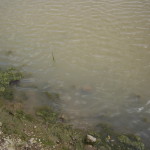 Muddy water is often a problem in Texas Farm ponds because it inhibits the growth of natural fish foods and is not aesthetically pleasing. In addition, the reduced visibility in muddy ponds limits the ability of sight-feeding predators, such as large-mouth bass, to feed on forage populations effectively.
Muddy water is often a problem in Texas Farm ponds because it inhibits the growth of natural fish foods and is not aesthetically pleasing. In addition, the reduced visibility in muddy ponds limits the ability of sight-feeding predators, such as large-mouth bass, to feed on forage populations effectively.
The first step in clearing ponds is to inspect the watershed and shoreline for signs of erosion. Grass sod should be established on bare areas. Rocks or other rip-rap material should be placed on shorelines of larger ponds if eroded by wave action.
Many ponds become temporarily muddy following heavy rains, but clearing usually occurs in a few days. Abundant bullhead catfish and/or common carp populations may also cause muddy conditions and should be eliminated.
If heavy rainfall or undesirable fish are not causing muddy conditions, the cause is negatively charged clay particles. These particles repel each other and will not settle out. The addition of positively charged particles causes coagulation and precipitation of clay particles.
Compounds recommended for clearing ponds include agricultural limestone, alum (aluminum sulfate) hydrated limestone and gypsum (calcium sulfate). The compound utilized should be determined by its cost, availability and effectiveness.
Ponds in East Texas require special consideration because of their typically low pH and total alkalinity. Water samples should be analyzed to determine the need for agricultural limestone applications. The addition of this compound often clears East Texas Ponds.
Ponds in other areas of the state usually can be cleared with gypsum. However, tests should be run on each muddy pond to determine the type and amount of compound to use because condition vary so greatly.
These tests can be run by obtaining several 1-gallon samples of pond water in glass jars. One of the gallon samples should be set aside as a control for comparison. A second gallon jug is needed to prepare a slurry for each compound tested. At least three other samples should be treated at various rates to determine the rate and type of compound that provides the most satisfactory results.
Gypsum
Mix 2 level tablespoons (use a standard measuring spoon) of gypsum in 1 gallon of clear water. Stir until gypsum is in a slurry.
Number of tablespoons slurry Rate of gypsum to apply
added to 1 gallon pond to pond if sample clears
water samples in 12 hours (lbs/acre-foot)
1 80
2 160
3 240
4 320
5 400
6 480
7 560
8 640
9 720
10 800
11 880
12 960
Alum
Mix 1 level tablespoon (use a standard measuring spoon) of alum in 1 gallon of clear water. Stir until alum is in a slurry.
Number of tblsp Rate of alum to For East Texas For other pond,
slurry added apply to pond if ponds,* also add also add hydrated
to 1 gallon pond sample clears in hydrated lime at lime at the rate
water samples 12 hours (lbs/acre-ft) the rate of (lbs/acre-ft) of (lbs/acre-ft)
1 30 13 0
2 60 26 0
3 90 39 13
4 120 52 17
*First submit a water sample to determine the need for agricultural limestone applications for East Texas ponds.
The lowest concentration that will precipitate the colloidal clay in 12 hours should be used to treat the pond. Remember to add hydrated lime as indicated if alum is used for treatments. Be sure to consider the economics between gypsum and alum/hydrated lime.
written by Don Steinbach & Billy Higginbotham
